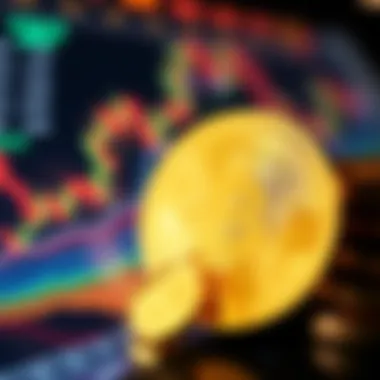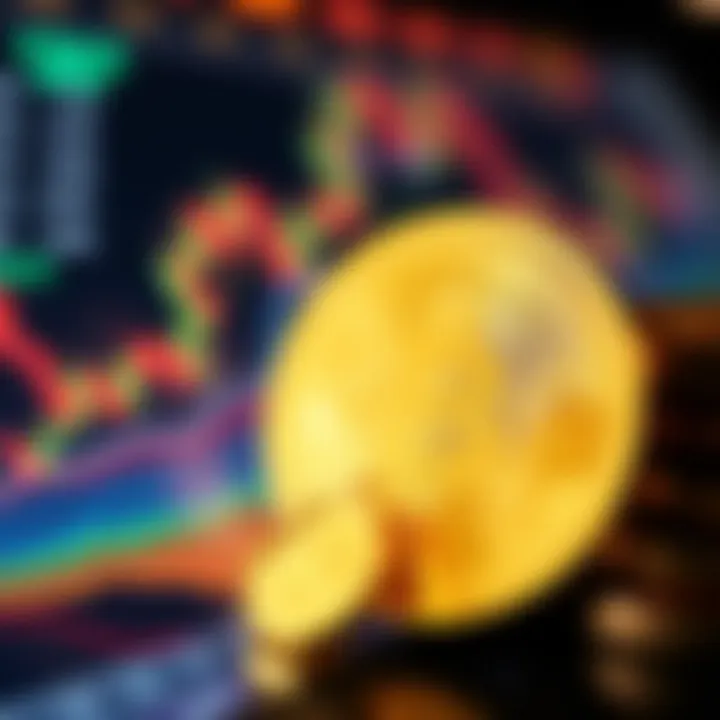Top Cryptocurrency Exchanges: Comprehensive Overview


Intro
In the ever-evolving world of digital assets, understanding cryptocurrency exchanges is essential for anyone looking to dip their toes into trading or investment. From the moment you decide to invest your hard-earned money, the choice of an exchange can shape your entire experience. Given that exchanges serve as the gateway to the cryptocurrency market, it's crucial to dissect their features, user experiences, and overall trustworthiness.
Cryptocurrency exchanges vary widely; some are user-friendly for novices, while others cater to seasoned traders with advanced tools and features. This article provides a detailed walkthrough of the top exchanges, diving into aspects like security protocols, trading fees, liquidity, and the inventory of cryptocurrencies on offer.
Additionally, as the cryptocurrency landscape shifts, keeping up with the latest trends becomes vital for making informed choices. Whether you are a casual trader, an adventurous investor, or someone involved in development, grasping these exchanges' nuances can empower your decision-making process. Through various sections, this article aims to impress upon readers not just the technical meanderings of exchanges, but also the various subtleties that can often make the difference in one's investing journey.
Let’s embark on a thorough exploration of the cryptocurrency exchanges that define this fascinating digital frontier.
Prelims to Cryptocurrency Exchanges
The world of cryptocurrencies has grown exponentially, carving a niche for itself in the realm of digital finance. This expansion has given rise to various cryptocurrency exchanges, essential platforms that facilitate the buying, selling, and trading of digital currencies. Understanding what these exchanges are and how they function is vital for anyone venturing into the cryptocurrency space.
Cryptocurrency exchanges act as intermediaries between buyers and sellers, much like a traditional stock exchange does for equities. However, the unique nature of cryptocurrencies means these exchanges have adopted features tailored specifically for digital assets. Each platform offers a range of services, from simple buying and selling to complex trading features, catering to both novices and seasoned investors.
Selecting a cryptocurrency exchange is not just about finding the cheapest one. Investors must consider several elements such as security, user experience, transaction fees, and the variety of cryptocurrencies offered. For example, a secure exchange with a convoluted user interface may deter potential users, while a visually appealing platform lacking in security might expose traders to potential risks. Knowing these factors can help investors make informed decisions.
Moreover, different exchanges support different cryptocurrencies. While some may focus on mainstream coins like Bitcoin and Ethereum, others might offer a broader range of altcoins. Choosing an exchange that aligns with one's trading goals is crucial. Additionally, aspects such as liquidity and trading volume can significantly affect trading efficiency and market stability.
In essence, cryptocurrency exchanges are the gateway for entering the crypto market. They play a fundamental role in how investors engage with digital assets. The right choice of exchange can pave the way for a successful trading experience, while the wrong one may lead to frustration and financial loss. As we delve deeper into this article, we'll explore criteria for selecting the best exchanges and evaluate the leading platforms in this space.
Criteria for Selecting a Top Exchange
In the ever-evolving world of cryptocurrency, choosing the right exchange is no small feat. It’s like finding a needle in a haystack — or perhaps more akin to striking gold amid a sea of options. Investors and traders alike need to consider various criteria that reflect both the operational integrity and user-friendliness of these platforms. The metrics you prioritize can have a direct impact on your trading experience, ensuring that you not only protect your assets but also enhance your overall performance in the market. Let’s break down the vital components to keep in mind when selecting a top exchange.
Security Features
Security is paramount in the realm of digital currencies. Without robust security measures, even the most experienced traders could fall victim to hacks or loss of funds. Top exchanges typically employ advanced encryption technologies, multi-signature wallets, and strict Know Your Customer (KYC) protocols to enhance user protection.
Some notable security features to look for include:
- Two-Factor Authentication (2FA): This adds an extra layer of protection by requiring not just a password but also a second verification method, like a text message code.
- Cold Wallet Storage: Look for exchanges that store most of their assets in offline wallets. This significantly reduces vulnerability to online attacks.
- Regular Security Audits: Platforms that undergo consistent audits demonstrate a commitment to maintaining a secure environment.
Investors must weigh these security attributes heavily when making their selections. After all, foregoing a secure exchange for potentially higher trading fees may not be a wise trade-off.
User Experience and Interface
User experience greatly influences how effectively one can utilize an exchange. An intuitive interface can make navigating complex trading tools a breeze, while a clunky design might leave even seasoned traders feeling frustrated. Look for exchanges that offer:
- Easy Navigation: Critical functions should be accessible within a few clicks. From trading to account management, an efficient layout is key.
- Mobile Compatibility: As remote trading grows, platforms that support mobile trading through user-friendly apps can offer significant flexibility.
- Educational Resources: The presence of tutorials or help guides can aid users in optimizing their trading strategies, particularly for those who are new to the arena.
A user-friendly experience can save time and reduce error, making it easier to pivot swiftly in a fast-paced market.
Fees and Trading Costs
Understanding the fee structure is essential for traders looking to maximize their profits. Not all exchanges are created equal when it comes to fees, which generally fall into several categories, including:
- Trading Fees: Many exchanges charge a percentage per trade, which varies based on transaction volume.
- Withdrawal Fees: Transferring funds off the exchange can also incur costs. These fees can diminish overall returns, so it’s prudent to familiarize yourself with the fine print.
- Deposit Fees: Although many exchanges offer free deposits, others charge fees for various payment methods.
It’s advisable to calculate potential costs for your trading strategy, as fees can compound over time, especially for frequent traders.
Supported Cryptocurrencies
The number of cryptocurrencies supported by an exchange can dictate not just the diversity of an investor’s portfolio but also their ability to engage with emerging market trends. Top exchanges should offer:
- Major Coins: Look for exchanges supporting Bitcoin, Ethereum, and other well-established options.
- Altcoins: A robust selection of altcoins can provide opportunities to tap into new market developments.
- Stablecoins: Having stablecoins available for trade can enhance trading strategies, allowing users to navigate volatility without severe losses.
Investors should prioritize exchanges that align with their interests, especially if they plan to diversify into lesser-known offerings.
Liquidity and Trading Volume
Liquidity measures how easily assets can be bought or sold without significantly affecting the price. High trading volumes often indicate that an exchange is liquid, which is a crucial factor for serious traders. Key considerations include:


- Order Book Depth: A thicker order book generally means better liquidity.
- Market Activity: Exchanges with high trading volumes might be more dynamic, leading to quicker trades at more favorable prices.
- Withdrawal Limits: Consider whether withdrawal limits impact your ability to manage your assets efficiently.
A liquid market ensures that transactions can be executed seamlessly, sparing traders from unnecessary frustrations and losses.
In summary, evaluating these criteria can provide invaluable insights into which exchange aligns with your trading strategy and goals. Each element plays a crucial role in shaping your overall experience in the cryptocurrency landscape, therefore, it pays to do your homework before signing up.
Overview of the Top Five Exchanges
When diving into the world of cryptocurrency, having a reliable exchange is like having a sturdy lifeboat in uncharted waters. It’s imperative to understand not just what the top exchanges are but also the specific traits that set them apart from the rest. This section provides a thorough look into five of the foremost cryptocurrency exchanges available today, outlining their distinct features, user experiences, and competitive advantages.
Examining these exchanges goes beyond mere surface details; it's about unraveling how they adapt to the ever-changing landscape of digital currencies. Investors and traders need a solid grasp of various elements, such as security features, trading fees, liquidity, and user support to make informed decisions.
In this analysis, we’ll dissect the components that make these exchanges not just popular but effective in meeting the needs of a diverse user base. Thus, readers will gain a comprehensive understanding of what they can expect from each platform along with tips on how to leverage these insights for their trading strategies.
Exchange One: A Comprehensive Review
Security Measures
Security is the bedrock of any cryptocurrency exchange, and no one wants to lose hard-earned assets due to lax protection. Exchange One incorporates multiple layers of security, including two-factor authentication and cold storage for the majority of user funds. What makes this exchange a standout choice is its innovation in utilizing smart contract technology to prevent fraud and ensure transactions are safe.
The unique feature here is the real-time monitoring of suspicious activities, which gives users peace of mind. This proactive approach contributes significantly to its reputation as a reliable exchange. However, one potential downside could be the slightly complicated verification process which may deter first-time users.
Trading Fees
When it comes to trading costs, Exchange One offers a tiered fee structure based on the user's trading volume. This means the more you trade, the lower your fees become. Such a structure is beneficial for high-frequency traders who seek to maximize their returns. A key characteristic of these fees is their transparency, which allows users to understand exactly what they are paying for.
Yet, a unique feature to consider is the introduction of promotional periods where fees can be significantly reduced. However, one might argue that during off-peak times, the regular fees can still be on the higher side compared to competitors.
User Feedback
User feedback acts like a compass guiding newcomers toward safe trading experiences. At Exchange One, customer reviews highlight the platform's intuitive navigation and responsive customer service. This exchange consistently receives commendations for its straightforward interface and educational materials aimed at novice traders, making it more accessible than many others.
That being said, a persistent critique involves occasional downtimes during peak trading hours, an aspect that can frustrate users looking to capitalize on market fluctuations.
Exchange Two: Analyzing Key Features
Interface Usability
User interface (UI) is a crucial aspect in how traders engage with the platform. Exchange Two smartly focuses on user-friendly design with customizable features that allow traders to tailor their experience. Navigation is seamless, even for those who aren’t tech-savvy. The platform also offers a mobile application that mirrors the full desktop experience, further increasing accessibility.
However, some users note that while the design is aesthetically pleasing, it may lack certain advanced features that seasoned traders find beneficial. This trade-off can impact those looking for in-depth analysis tools.
Available Cryptocurrencies
Diversity in trading options can significantly influence an exchange's appeal. Exchange Two boasts an expansive list of cryptocurrencies, including many altcoins that lesser exchanges do not support. This characteristic is especially attractive to investors looking to diversify their portfolios.
Despite this, one limitation is that the exchange might not list emerging coins immediately, which could leave some users feeling a bit behind the curve. This is a double-edged sword, as an early adoption of popular coins often attracts new users.
Liquidity Assessment
Liquidity refers to the ease of buying or selling assets without causing significant price changes. Exchange Two demonstrates respectable liquidity levels, especially in major cryptocurrencies. This is beneficial in enabling users to execute trades swiftly with minimal slippage. The unique feature lies in their depths of order books, which facilitates high-volume transactions, making it appealing for day traders.
However, potential investors should note that liquidity can be less favorable during off-peak trading times, possibly impacting execution speeds.
Exchange Three: Evaluating Performance
Customer Support
Customer support is vital for maintaining user trust, especially in times of technical difficulties. Exchange Three offers 24/7 customer support through various channels, including live chat, email, and even social media. This commitment underscores their dedication to customer service, making it highly regarded among traders.
A unique aspect is their knowledge base, equipped with extensive articles and FAQs, which helps users resolve common issues quickly. But on the flip side, during peak trading times, users have reported longer waiting times for live assistance, which could be frustrating.
Withdrawal Processes


The withdrawal process at Exchange Three has been noted for its efficiency, which can be a significant factor for liquidity. Users are typically able to withdraw funds with a few clicks, often completed within hours. This is essential for traders who require immediate access to their money. Moreover, they offer several withdrawal options, accommodating users' preferences.
However, a downside could be the withdrawal fees, which may be higher than those of some other exchanges depending on the chosen withdrawal method.
Market Position
Understanding where an exchange stands in the broader market can inform risk assessments. Exchange Three has maintained a strong market position, often ranked among the top exchanges based on user volume and trading activity. This stability contributes positively to user confidence.
But one must consider that market dynamics can change rapidly. Such stability could shift if newer competitors emerge with unique offerings that draw users away.
Exchange Four: Competitive Advantages
Fee Structures
Exchange Four sets itself apart with its competitive fee structures that cater to various trading strategies. The base fees are relatively low, making it a favorable option for both casual and frequent traders. Additionally, they offer flat rates for certain types of accounts that can lead to significant savings.
Yet, a unique feature is the introduction of a loyalty program that rewards long-term users with even lower fees. However, it is essential to be mindful of the fine print, as certain conditions may apply, which could complicate matters for some users.
Trading Options
The variety of trading options available can enhance user experience, and Exchange Four shines in this respect. This exchange supports numerous trading pairs and offers features like margin trading and futures contracts. Such flexibility can attract both new and seasoned traders looking to diversify their approaches.
However, it's worth noting that the complexity of these features might overwhelm novice users who are more accustomed to basic trading.
Regulatory Compliance
In an industry still finding its feet, regulatory compliance is crucial. Exchange Four prides itself on its robust compliance measures, being fully licensed in several jurisdictions. This contributes to their credibility and assurance for users worried about potential risks in the crypto landscape.
Nonetheless, navigating regulatory frameworks can be complicated, and the exchange's operational constraints might limit some functionalities depending on users' locations.
Exchange Five: Insights and Analysis
Security Protocols
Security is once again a focal point with Exchange Five as they continue to evolve their security protocols. They utilize advanced encryption methods alongside decentralized security measures to protect users' funds. This makes the exchange particularly attractive for those prioritizing security over everything else.
A unique aspect of Exchange Five is the integration of biometric verification for account access, adding another layer of security. However, this high level of security might complicate usability for some traders who prefer simplicity.
User Demographics
Understanding user demographics can provide insight into the exchange's market reach. Exchange Five attracts a mix of experienced traders and curious newcomers. Its welcoming interface and educational resources support this blend, which is beneficial for enhancing community knowledge.
However, the diverse user base might lead to mixed feedback, where experienced traders might seek more advanced tools, while new users look for step-by-step guides and simpler features.
Future Enhancements
Exchange Five takes future advancements seriously, often investing heavily in research and development. Features such as automated trading tools and advanced analytics are set to be introduced as part of their effort to stay ahead of the competition. These upgrades suggest a commitment to adapting to users' changing needs in a fast-paced market.
Yet, with innovation, some users may find the transition challenging, particularly if they become accustomed to the platform's existing features.
Security Considerations Across Exchanges
In the fast-paced world of cryptocurrency, security is not just an option; it’s a necessity. As investors and traders flock to digital exchanges, the potential risks lurking in the shadows can’t be ignored. With hacking incidents making headlines more frequently than we’d like, understanding security considerations becomes paramount for every user involved in cryptocurrency transactions.
A solid grasp of security practices can spell the difference between keeping one's assets safe and facing crippling losses. One's trust in an exchange often rests upon how secure its infrastructure truly is. The reality is, if you don’t take measures to protect yourself, you’re playing a risky game.
Common Threats to Users
Every cryptocurrency exchange, regardless of its stature, faces various threats. Recognizing these risks is the first step in safeguarding one's investments. Here are several notable dangers:
- Phishing Attacks: Users often fall prey to deceptive messages that mimic legitimate exchanges, misleading them into sharing private information.
- Malware Infections: Sophisticated malware can capture login credentials. This may result in unauthorized access to accounts, ultimately leading to significant losses.
- Exchange Vulnerabilities: While top exchanges work tirelessly to maintain tight security, vulnerabilities in their systems can still be exploited by malicious actors.
- Lack of Two-Factor Authentication (2FA): Some exchanges still give users the option of forgoing 2FA, significantly increasing the risk for account breaches.
- Social Engineering: Attackers can manipulate individuals into revealing sensitive information, often through impersonation or fraudulent requests.
Understanding these threats can help in making informed decisions when choosing an exchange. It is not just about trading successfully; it’s about securing your assets against potential losses that may arise from slipping up.


Best Practices for Secure Trading
Even if an exchange embodies security, users play a crucial role in their own protection. Many practices ensure a user remains steadfast against rising threats. Engage in proactive measures that not only protect your investments but also enhance overall confidence in trading. Here are best practices one should incorporate:
- Enable Two-Factor Authentication: This adds an extra layer of security; your username and password won’t suffice for those without your phone.
- Use Strong Passwords: Don’t opt for an easily guessable password like “123456”. Combine letters, numbers, and characters for a tailored mix.
- Keep Software Updated: Ensure that your devices and any wallet software are consistently updated to ward off potential vulnerabilities.
- Utilize Hardware Wallets: For larger holdings, consider using hardware wallets that store cryptocurrencies offline, significantly reducing the risk of hacks.
- Be Aware of Phishing Attempts: Double-check URLs and avoid clicking on suspicious links. If something seems fishy, it probably is.
- Limit Information Shared: Guard your account details fiercely; it’s not a good idea to overshare on social media.
Staying secure in the digital arena is not just about relying on the exchange; it’s about playing an active role in protecting your investments.
These practices don’t guarantee absolute security, but they’re invaluable steps in minimizing risk. In an ever-evolving landscape, every layer of protection counts. By being conscious of security considerations both from an exchange and a personal standpoint, users can navigate the cryptocurrency realm with greater confidence and resilience.
Comparative Analysis of Fees
Understanding the Comparative Analysis of Fees is crucial for anyone navigating the realm of cryptocurrency exchanges. Fees represent more than just a monetary charge; they can greatly impact one’s investment strategy and overall profitability. Given the diversity of exchanges, the fees associated with transactions can vary significantly. This section will demystify the different types of fees and examine how they influence trading strategies. It's a labyrinth of costs that, when properly understood, can empower an investor to make more informed decisions.
Types of Fees Explained
In the world of cryptocurrency trading, several types of fees come into play. It's essential to recognize each fee type and their implications:
- Trading Fees: Generally, these are a percentage of each trade made on the exchange. Most platforms employ either a maker-taker fee structure or a flat fee. A maker fee is charged when you place a limit order that adds liquidity, while a taker fee applies to market orders that take liquidity. For example, Binance’s fees start as low as 0.1% for both maker and taker players.
- Withdrawal Fees: Every time you withdraw your cryptocurrency to your wallets, exchanges often charge a flat fee. This can vary widely depending on the type of cryptocurrency being withdrawn. For example, withdrawing Bitcoin may cost up to 0.0005 BTC, while Ethereum could incur a fee of around 0.006 ETH.
- Deposit Fees: Some exchanges impose fees when you deposit funds, especially through credit cards or instant bank transfers. While most platforms offer free deposits through methods like bank transfers, using a credit card can lead to fees that slice into your investment.
- Inactivity Fees: Some exchanges charge a penalty if an account remains inactive for a specific period. For instance, if you’ve been sitting on your hands for six months, you're bound to be charged $10 a month until you wake up and start trading again.
- Conversion Fees: When trading pairs involve converting currencies, exchanges may charge conversion fees, especially if the currency being traded doesn't align directly with the user’s account currency.
Understanding these fees is the first step in navigating the complex trading landscape and can spell the difference between profit and loss.
Impact of Fees on Trading Strategies
The impact of fees on trading strategies cannot be underestimated. High fees can chip away at profits, particularly for high-frequency traders who execute numerous trades within short timeframes. On the flip side, those opting for long-term investment strategies may not feel the pinch as acutely. Nonetheless, even a small percentage fee can accumulate significantly over time, leading to noticeable losses on larger portfolios.
Encapsulating this, think of trading fees as tolls on a highway: the more frequently you travel that road, the more you pay. Hence, as part of your trading strategy, consider the following:
- Volume-Based Trading: One way to mitigate fees is to focus on trading less frequently but in higher volumes. Many exchanges reduce fees for high-volume traders, rewarding those willing to commit to larger transactions.
- Long-Term Strategy: If you engage in a long-term investment strategy, you can usually afford to overlook transaction fees, especially if you believe in the long-term appreciation of the cryptocurrencies involved.
- Choosing the Right Exchange: Some exchanges offer competitive fees and others do not. It pays to shop around and align your trading needs with the exchange’s fee structure.
"It's not just about the coin you trade; it's about the fees you pay that could change the game."
Market Trends Influencing Exchange Operations
Understanding market trends that affect cryptocurrency exchanges is paramount. The landscape is constantly shifting, influenced by advancements in technology, regulatory developments, and competitor strategies. Staying ahead of these trends not only helps exchanges to adapt but also provides investors with insights into the operational dynamics of these platforms. This section unveils current market movements that every trader and investor must be aware of when navigating the cryptocurrency terrain.
Emerging Competitors
The rise of new exchanges is shaping the competitive landscape in the digital asset space. Each new entry often brings unique features, user incentives, and sometimes lower fees. For instance, platforms like Binance and Kraken have recently seen newer players such as Crypto.com and FTX making waves with attractive offerings. Investors should consider the following when evaluating these emerging competitors:
- Innovative Features: New exchanges frequently introduce cutting-edge functionalities like advanced trading options or integrations with DeFi protocols. This can enhance trading efficiency and broaden the asset selection.
- User Incentives: Promotions, loyalty programs, and staking rewards are strategies newer competitors deploy to attract users. Always look for potential bonuses that can boost your trading experience.
- Regulatory Compliance: Some new exchanges prioritize transparency and compliance, which may hold sway for many investors concerned about legal implications.
Choosing the right exchange may involve weighing the merits of these fresh players against established names. The continually evolving market keeps everyone on their toes and offers opportunities for those willing to explore.
Regulatory Changes
Regulatory developments are another major component influencing cryptocurrency exchanges. Governments around the globe grapple with how to handle the burgeoning crypto market, often resulting in fluctuating policies and standards. As such, it’s critical to keep an eye on the regulatory landscape, especially in key regions.
- Licensing and Compliance: Some jurisdictions demand thorough verification processes for exchanges to operate legally. Staying compliant means exchanges can gain trust amongst users, leading to greater adoption rates.
- Tax Implications: Various countries are implementing changes in how cryptocurrencies are taxed. Being aware of how your exchange manages these aspects can save investors significant headaches down the road.
- International Standards: Regulatory bodies often push for international frameworks that can either facilitate or hinder market growth. Following these trends will arm investors with the knowledge needed to make informed decisions about where to trade.
"Understanding regulatory shifts is not just for compliance; it can also reveal potential market opportunities and risks that can affect your investments in the long run."
Keeping tabs on these regulatory changes not only maintains operational legitimacy but can position exchanges favorably in the market against less compliant competitors.
Finale and Future Outlook
In the fast-paced world of cryptocurrency exchanges, understanding the intricacies of this financial ecosystem is paramount. As evident throughout this article, the myriad factors contributing to selecting an exchange encompass everything from security features to user experience, trading costs, and liquidity. These elements play a crucial role in shaping the choices that investors make when navigating the murky waters of digital currency transactions. The conclusion synthesizes this information into actionable insights that cater to both new and seasoned investors.
When contemplating which exchange to choose, it’s essential for investors to weigh the pros and cons of each platform carefully. Findings from the detailed evaluations highlight that security should be a top priority. Without robust protective measures, even the best trading strategies can falter. Similarly, understanding the fee structures can significantly impact trading profitability; lower fees often equate to better margins for investors.
Furthermore, keeping an eye on the liquidity levels of each exchange will assist traders in executing strategies more efficiently. An exchange with high liquidity typically allows for quicker, smoother transactions, which can be a lifesaver in volatile market conditions. Therefore, being informed about these key elements empowers investors to make choices that align with their financial goals and risk tolerance.
Key takeaways for Investors
- Prioritize Security: Ensure that the chosen exchange employs high-security protocols, such as two-factor authentication and cold storage options for cryptocurrencies.
- Assess Fee Structures Closely: Be wary of hidden fees. It’s advisable to choose platforms that are transparent about their fee policies to prevent unexpected costs that might eat into profits.
- Evaluate User Experience: A user-friendly interface can greatly enhance trading efficiency. Look for exchanges that emphasize ease of use, especially for those new to cryptocurrency.
- Liquidity is Key: Higher liquidity generally means better prices with lower slippage, making it easier to execute trades efficiently.
- Regulatory Compliance Matters: Engaging with exchanges that adhere to local regulations can protect investors, as compliance often means an additional layer of oversight and trustworthiness.
Anticipated Developments in Exchange Market
The cryptocurrency exchange market is ever-evolving, with rapid advancements not just in technology but also in regulatory frameworks. Understanding these anticipated developments can help investors stay ahead of the curve:
- Increased Regulatory Scrutiny: As governments worldwide move towards tighter regulation of cryptocurrencies, exchanges may face new compliance challenges. This could impact their operational frameworks and potentially influence costs passed onto users.
- Integration of Advanced Technologies: With the rise of blockchain technology, we may see exchanges adopting decentralized finance solutions, automating trading processes even further, and enhancing security measures.
- Expansion of Services Provided: Many exchanges are already expanding their service offerings beyond just trading. Features such as yield farming, staking opportunities, and robust educational resources are likely to gain traction.
- Market Maturity: As the cryptocurrency space continues to mature, we might witness a consolidation of exchanges. Smaller players might either pivot or get absorbed into larger firms, allowing for more streamlined operations and a focus on customer-centric features.















